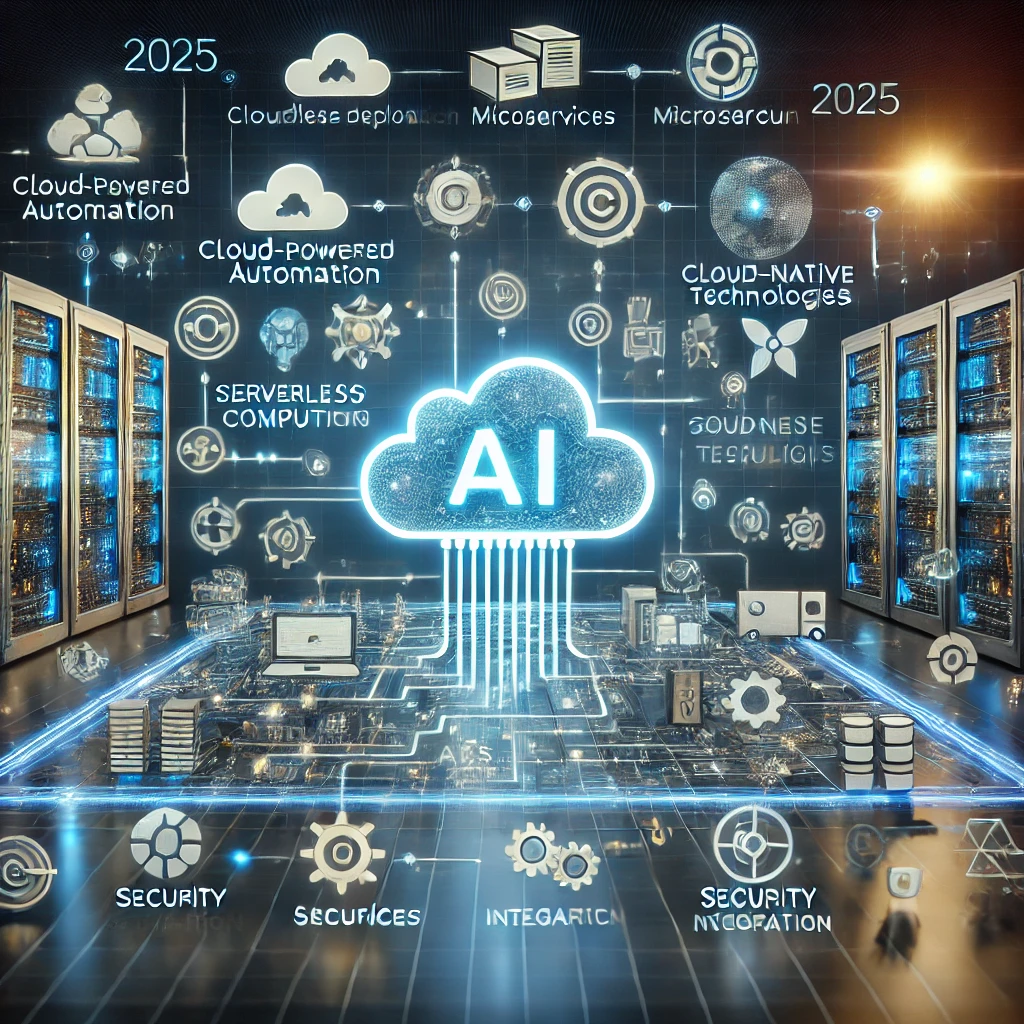From Silos to Synergy: The Shifting Sands of DevOps"
The Rise of the Machines: DevOps in 2025
A Glimpse into the Future :-
- The future of DevOps is one of automation, intelligence, and seamless integration. Imagine a world where deployments happen instantaneously, infrastructure scales automatically, and security vulnerabilities are identified and patched before they can be exploited. This is the vision of DevOps in 2025, a reality fueled by cutting-edge tools and innovative practices.
- But the journey won't be without its bumps. As technology evolves, so too will the challenges. Keeping pace with this rapid evolution requires a commitment to continuous learning, adaptation, and a willingness to embrace change. The future belongs to those who can anticipate and adapt to the changing landscape of DevOps.
The Shifting Sands of DevOps :-
- DevOps is no longer just about automating deployments. It is becoming an integral part of the entire software development lifecycle, from ideation to production and beyond. This shift requires a more holistic approach, one that integrates security, compliance, and business objectives into every stage of the process. The days of isolated teams working in silos are numbered.
- Moreover, the rise of cloud-native technologies, serverless computing, and AI/ML is transforming how we build and deploy software. The tools and technologies we rely on today may become obsolete tomorrow, requiring us to constantly evaluate and adapt our strategies. This constant evolution is both exciting and challenging, requiring continuous learning and a willingness to embrace new tools and techniques.
Top 10 DevOps Tools to Watch in 2025
GitLab: The All-in-One Platform :-
- GitLab is more than just a Git repository; it's a comprehensive DevOps platform offering features ranging from code management and CI/CD to monitoring and security. Its all-in-one approach simplifies workflows and reduces the need for multiple tools, improving collaboration and streamlining processes. The ability to manage the entire DevOps lifecycle within a single platform reduces complexity and enhances efficiency.
- GitLab’s strength lies in its comprehensive suite of integrated tools. This eliminates the need to juggle multiple platforms, minimizing the risk of integration issues and reducing the complexity of the overall DevOps workflow. Imagine seamless transitions from code development to testing, deployment, and monitoring, all within one platform. This integration streamlines processes and accelerates the delivery of applications.
Jenkins: The Automation Workhorse :-
- Jenkins remains a powerhouse in the world of CI/CD, providing a robust and flexible platform for automating builds, tests, and deployments. Its vast plugin ecosystem allows for customization to fit virtually any workflow. Its open-source nature and extensive community support ensure a constant flow of updates, improvements, and a readily available support network.
- Jenkins' adaptability is one of its greatest strengths. Its plugin ecosystem provides a level of customization that is unmatched. Whether you need to integrate with specific tools, platforms, or cloud providers, Jenkins can likely be configured to meet your needs. This flexibility allows it to be adapted to any DevOps environment, regardless of its complexity or unique requirements. AI Prompt: A colorful, modern diagram showing the various stages of a Jenkins CI/CD pipeline, highlighting its key features and extensibility.
Docker: Containerization King :-
- Docker remains the undisputed leader in containerization, simplifying application deployment and management by packaging applications and their dependencies into isolated containers. This ensures consistent execution across different environments, eliminating the dreaded “works on my machine” problem. Its ease of use and widespread adoption have solidified its position as a cornerstone of modern DevOps.
- Docker's portability is a key advantage. Containers can be easily moved between development, testing, and production environments without modification. This simplifies deployment and reduces the risk of inconsistencies caused by environment-specific configurations. The ability to package applications and their dependencies ensures consistent execution regardless of the underlying infrastructure.
Kubernetes: Orchestrating the Chaos :-
- Kubernetes takes container orchestration to the next level, automating the deployment, scaling, and management of containerized applications across clusters of machines. Its powerful features ensure high availability, scalability, and resilience, making it essential for large-scale deployments. Its community support and the abundance of resources make it a valuable asset for complex projects.
- The scalability of Kubernetes is remarkable. It can easily manage hundreds or even thousands of containers across multiple clusters. This makes it ideal for organizations that need to handle high traffic volumes and rapidly scaling applications. The automated deployment, scaling, and management features free up DevOps engineers to focus on other critical tasks.
Terraform: Infrastructure as Code :-
- Terraform allows you to define and manage your infrastructure as code, providing a consistent and repeatable way to provision and manage cloud resources. This eliminates manual configurations, reducing errors and improving consistency. Its support for multiple cloud providers makes it a versatile tool for managing hybrid and multi-cloud environments.
- Terraform enables infrastructure automation, ensuring consistency and repeatability across different environments. This automation reduces the likelihood of human error, a common source of problems in infrastructure management. By treating infrastructure as code, Terraform provides a version-controlled, auditable approach to managing cloud resources.
Ansible: Automating Everything :-
- Ansible simplifies IT automation, allowing you to automate configuration management, application deployment, and other IT tasks across your infrastructure. Its agentless architecture simplifies deployment and reduces overhead. Its intuitive syntax and ease of use make it accessible to a wide range of users, from system administrators to DevOps engineers.
- Ansible's agentless architecture is a key differentiator. This eliminates the need to install agents on managed systems, simplifying deployment and reducing the overall management overhead. This approach also improves security by reducing the attack surface.
Chef: Configuration Management Maestro :-
- Chef is a powerful configuration management tool that uses a declarative approach to manage infrastructure. This allows you to define the desired state of your systems, and Chef will ensure that they are always in that state. Its robust features and extensive community support have made it a popular choice for large-scale deployments. It is often used in conjunction with other tools such as Puppet and Ansible.
- Chef’s declarative approach simplifies configuration management by focusing on the desired state of the system rather than the specific steps required to achieve it. This makes it easier to manage complex infrastructures and to ensure consistency across multiple systems. It is particularly well-suited for large organizations with complex IT environments.
Puppet: Infrastructure Automation Powerhouse :-
- Puppet is another leading configuration management tool that provides a robust and scalable solution for managing infrastructure as code. Its agent-based architecture provides a reliable mechanism for managing remote systems. Its extensive libraries and modules simplify complex configurations. It offers a more structured approach for larger, more complex infrastructure.
- Puppet's robust features and scalability make it a preferred choice for managing complex infrastructures. It provides a centralized approach to configuration management, ensuring consistency and repeatability across multiple systems. Its ability to handle complex dependencies makes it well-suited for large organizations with complex IT environments.
Prometheus: Monitoring the Unmonitored :-
- Prometheus is a leading open-source monitoring and alerting toolkit. It’s particularly effective at monitoring containerized environments. Its pull-based architecture simplifies monitoring and improves efficiency. Its flexibility and scalability make it ideal for even the largest deployments.
- Prometheus’s strength lies in its ability to monitor a wide range of metrics, providing comprehensive insights into the health and performance of your applications and infrastructure. Its powerful query language allows for complex analysis and the creation of sophisticated dashboards. Its flexibility allows seamless integration into various infrastructure setups.
Grafana: Visualizing the Data Deluge :-
- Grafana is a powerful open-source visualization tool that allows you to create interactive dashboards to monitor and analyze your data from multiple sources. It integrates seamlessly with various monitoring tools like Prometheus, allowing you to create comprehensive dashboards and gaining insights into your systems.
- Grafana's ability to create interactive and customizable dashboards provides a clear overview of your system's health and performance. This makes it easy to identify potential problems and take corrective action before they impact users. Its open-source nature and wide range of integrations make it a versatile and valuable tool.
Beyond the Tools: Trends and Predictions
AI-Powered DevOps :-
- Artificial intelligence and machine learning are poised to revolutionize DevOps. AI-powered tools can automate tasks, predict outages, and improve efficiency in ways previously unimaginable. Expect to see a surge in AI-powered tools that assist with code analysis, testing, and deployment, making the DevOps process even more efficient.
- The use of AI in DevOps will lead to more intelligent automation, reducing human error and improving the speed and efficiency of software delivery. AI-powered tools will also help to identify and predict potential problems, preventing outages and improving the overall reliability of applications. This represents a significant shift in how DevOps teams will work.
Serverless Computing and its Impact :-
- Serverless computing is rapidly gaining traction, offering a more efficient and scalable way to deploy and manage applications. This approach eliminates the need to manage servers, freeing up DevOps teams to focus on building and deploying applications. Expect to see a rise in serverless-based deployments and the adoption of serverless-specific tools and technologies.
- Serverless computing simplifies application deployment and management, reducing the operational overhead for DevOps teams. This allows teams to focus on developing and deploying applications rather than managing the underlying infrastructure. The scalability and cost-effectiveness of serverless computing also make it an attractive option for many organizations.
The Growing Importance of Security :-
- Security is no longer an afterthought; it's an integral part of the DevOps lifecycle. Expect to see increased focus on DevSecOps, which integrates security into every stage of the development process. New tools and technologies will emerge to address the ever-evolving security landscape. Security will be built-in from the very beginning of any development process.
- The shift towards DevSecOps highlights the critical need to integrate security into every phase of the software development lifecycle. This proactive approach helps to identify and mitigate security vulnerabilities early on, reducing the risk of breaches and improving the overall security posture of applications. This will lead to a much more secure future.
The Future of Cloud Computing :-
- Cloud computing will continue to be a driving force in DevOps, with the rise of multi-cloud and hybrid-cloud environments. Expect to see increased adoption of cloud-native technologies and tools that simplify the management of cloud-based resources. Cloud will continue to be a backbone of DevOps.
- The adoption of multi-cloud and hybrid-cloud strategies will enable organizations to leverage the strengths of different cloud providers while maintaining flexibility and resilience. Cloud-native technologies will continue to evolve, offering even greater scalability and efficiency for DevOps teams. This will allow a more flexible, distributed approach.
Conclusion: Embracing the Future of DevOps :-
- The future of DevOps is bright, but it will require continuous learning, adaptation, and a willingness to embrace change. By staying abreast of emerging trends, adopting new tools and technologies, and focusing on continuous improvement, DevOps teams can navigate the ever-evolving landscape and unlock the full potential of their operations.
- The key to success in the future of DevOps is a combination of embracing new technologies, continuous learning, and a focus on collaboration and automation. The tools and techniques discussed above are just a starting point. The future of DevOps will be shaped by the innovative solutions that are developed and implemented by DevOps teams worldwide. The future is exciting and full of possibilities!
Review
Kalpesh Shewale
I am grateful to have completed my Full Stack Development with AI course at Apnaguru. The faculty's support and interactive classes helped me discover my potential and shape a positive future. Their guidance led to my successful placement, and I highly recommend this institute.
Kalpesh Shewale
I am grateful to have completed the Full Stack Development with AI course at Apnaguru. The faculty's dedicated support and hands-on approach during the classes enabled me to unlock my potential and shape a promising future. Their guidance helped me secure a placement with a good package. I highly recommend this course, and for those interested, I also suggest doing the offline version at the center for an enhanced learning experience.

Raveesh Rajput
Completing the Full Stack Development with AI course at Apnaguru was a game-changer for me. I secured an internship through this course, which gave me invaluable hands-on experience. I strongly recommend this course to anyone looking to break into the tech industry. For the best experience, I suggest attending the offline sessions at the center, where the interactive learning environment really enhances the overall experience.

swapnil shinde
Apnaguru’s Full Stack Development with AI course provided me with more than just knowledge—it opened doors to an internship that gave me real-world, hands-on experience. If you're serious about a career in tech, this course is a must. I highly recommend attending the offline sessions for the most immersive and interactive learning experience!
Kalpana Waghmare
I recently completed the Full Stack Developer with AI course on ApnaGuru, and I couldn’t be more impressed! The structure of the course, with well-organized topics and self-assessment MCQs after each section, really helped reinforce my learning. The assignments were particularly valuable, allowing me to apply what I learned in a practical way. Overall, it’s an excellent program that effectively combines full-stack development and AI concepts. Highly recommended for anyone looking to enhance their skills!
Completing the Full Stack Development with AI course at Apnaguru was a pivotal moment in my career. It not only deepened my understanding of cutting-edge technologies but also directly led to an internship that provided practical, real-world experience. If you're aiming to enter the tech field, this course is an excellent stepping stone. I especially recommend attending the in-person sessions at the center, where the dynamic, hands-on learning approach truly maximizes the benefits of the program.

Mahesh Bhosle
I completed the Full Stack Development course at Apnaguru, and it was a valuable experience. The focus on live assignments and projects gave me real-world insights, helping me apply my skills in a professional setting. The interactive live sessions, mock interviews, and question banks were excellent for job preparation. Apnaguru’s company-like environment also helped me get accustomed to real work dynamics. Overall, this course equipped me with the skills and confidence needed for a career in full-stack development. I highly recommend it to anyone seeking hands-on learning and industry relevance.
I recently completed the Full Stack course at ApnaGuru, and I’m genuinely impressed! The curriculum is well-structured, covering both front-end and back-end technologies comprehensively. The instructors are knowledgeable and provide hands-on experience through practical projects. The supportive community and resources available made learning enjoyable and engaging. Overall, it’s a great choice for anyone looking to kickstart a career in web development. Highly recommend!

Adarsh Ovhal
I recently participated in the Full Stack Development With AI Course program, and it has been incredibly beneficial. The guidance I received was tailored to my individual needs, thanks to their advanced use of AI tools. The Trainers were knowledgeable and supportive, helping me explore various educational and career paths. The resources and workshops provided were practical and insightful, making my decision-making process much clearer. Overall, I highly recommend this program to any student looking for IT Field and personalized career guidance!
Shirish Panchal
I’m currently pursuing the Full Stack Developer with AI course at ApnaGuru Training Center, and I'm impressed with what I've experienced so far. The curriculum is well-structured, covering key concepts in both front-end and back-end development, along with AI fundamentals. The instructors are knowledgeable and supportive, which makes it easy to engage and ask questions. I particularly appreciate the hands-on projects that help reinforce what I’m learning. While I’m still in the process of completing the course, I feel that I'm building a strong foundation for my future in tech. I would recommend ApnaGuru to anyone looking to explore full stack development with AI!
Apnaguru Training Center stands out as a top-notch institute for IT education. They provide a wide array of courses, including Full Stack Development, Java Full Stack, Python, Automation Testing, DevOps, and MERN/MEAN Stack, all designed to meet the demands of the modern tech industry.

Mahesh Bhosle
Apnaguru Training Center is a fantastic place for IT education! They offer a variety of courses, including Full Stack Development, Java Full Stack, and Python, all taught by knowledgeable instructors who are committed to student success. The curriculum is up-to-date and includes hands-on projects that enhance learning.
dandewar srikanth
I had an excellent experience with the full-stack web development program at APNAGURU. The instructor had in-depth knowledge of both frontend and backend technologies, which made the concepts easy to grasp. From working on HTML, CSS, JavaScript, and React for the frontend to Node.js and MongoDB for the backend, the learning curve was very smooth.
